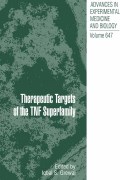
TNF superfamily has been the most highly investigated area of basic medical research for over two decades. These investigations have benefited from the enormous growth in our understanding of the principal functions of the immune system and the explosion in the knowledge involved in regulation of normal and pathological immune response. In addition, much has been learned about the molecular mechanisms of programmed cell death and the escape of tumor cells from apoptotic demise and from discovery of the key role played by TNF ligands in this process. As the functioning of these superfamily members is very complex, understanding TNF ligands and their receptor biology requires a mélange of research activities in many different disciplines including organ development, molecular biology, experimental pathology, and immunology. As a consequence of intensive studies in multiple areas over many years, much has been learned. INDICE: 1. Overview of TNF Superfamily: A Chest Full of Potential Therapeutic Targets. 2. Therapeutic Interventions Targeting CD40L (CD154) and CD40: The Opportunities and Challenges. 3. Targeting TNF for Treatment of Cancer and Autoimmunity. 4. Targeting of BAFF and APRIL for Autoimmunity and Oncology. 5. The Role of FasL and Fas in Health and Disease. 6. OX40 (CD134) and OX40L. 7. Targeting CD70 for Human Therapeutic Use. 8. 4-1BB as a Therapeutic Target forHuman Disease. 9. RANK(L) as a Key Target for Controlling Bone Loss. 10. Targeting the LIGHT-HVEM Pathway. 11. GITR: A Modulator of Immune Response and Inflammation. 12. Targeting CD30/CD30L in Oncology and Autoimmune and Inflammatory Diseases. 13. Tumor Necrosis Factor Receptor Superfamily Member 21: TNFR-Related Death Receptor-6, DR6. 14. TRAIL and Other TRAIL Receptor Agonists as Novel Cancer Therapeutics. 15. Therapeutic Potential of VEGI/TL1A in Autoimmunityand Cancer.
- ISBN: 978-0-387-89519-2
- Editorial: Springer
- Encuadernacion: Cartoné
- Fecha Publicación: 01/02/2009
- Nº Volúmenes: 1
- Idioma: Inglés
